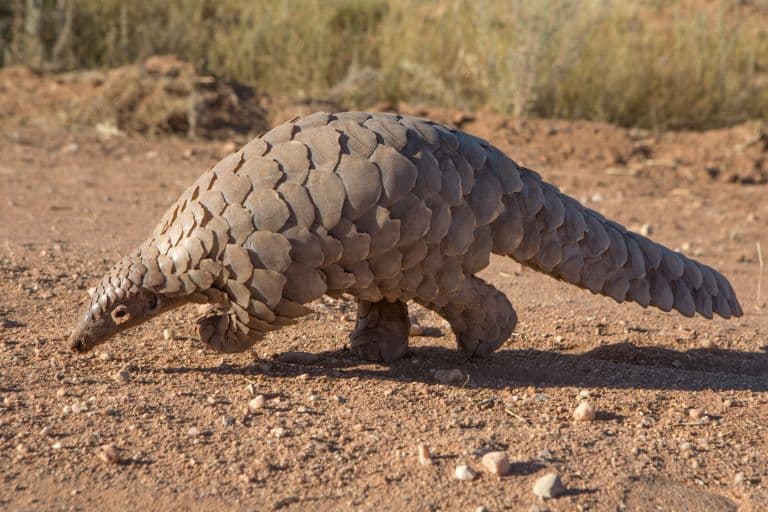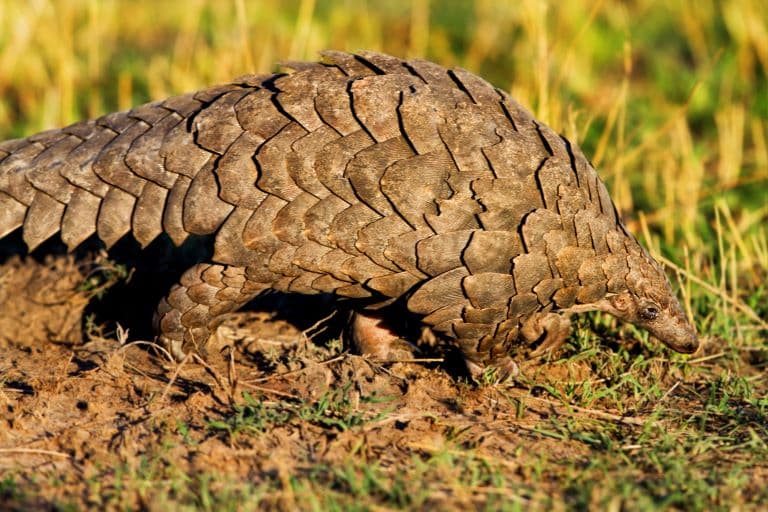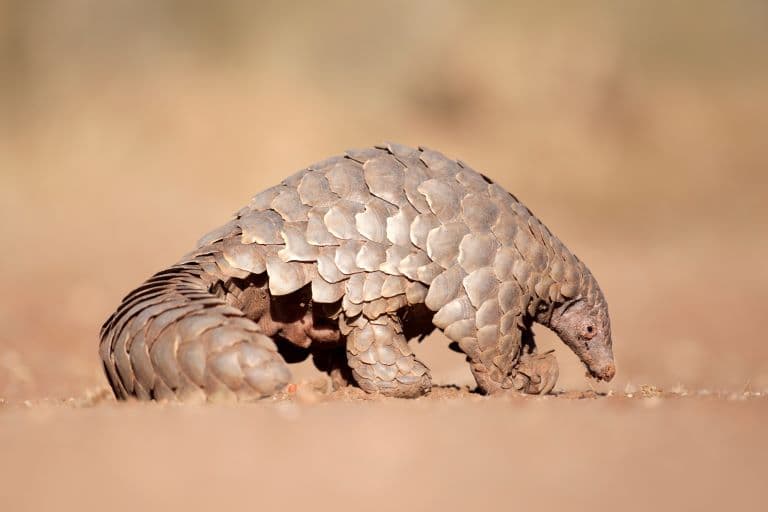Giant Pangolin Profile
The romanticised (and often overtly racist) depictions of Central Africa, from the Golden Age of naturalists, have a few enduring themes.
There are still vast swathes of impenetrable jungle, lost tribes and animals yet unknown to modern science. But even within groups of known animals, there are plenty that are barely understood.
The giant pangolin is a member of such a group: animals whose large sizes are offset by their sparse populations, elusive nature and remote habitats.
Unfortunately, not only is this insufficient to protect it from hunting, it’s also what makes its conservation so difficult.

Giant Pangolin Facts Overview
| Habitat: | Tropical forests and savannas |
| Location: | Western and Central Sub-Saharan Africa |
| Lifespan: | Unknown |
| Size: | Over 1.5 m (60 in) |
| Weight: | Up to 35 kg (77 lb) |
| Colour: | Brown |
| Diet: | Ants, termites |
| Predators: | Humans, others unknown |
| Top Speed: | Slow |
| No. of Species: | 1 |
| Conservation Status: | Endangered (IUCN) |
The giant pangolin, as its name would suggest, is the largest remaining pangolin species. But this would also suggest it would be easy to find, but pangolins are notorious contrarians.
This is an animal whose maximum weight is just shy of the common threshold for “Megafauna”, yet is so hard to spot that nobody knows how long it lives.
These mysteries are compounded by the vulnerability to disease and death that are seen in all captive pangolins, and sadly, this is hindering its protection against the animal’s only known predator: humans.
Interesting Giant Pangolin Facts
1. They’re huge
Pangolins rarely get to more than about 4 or 5 kg, and some are quite tinier than that. But this one, as the name implies, is a bit of a monster.
At up to 35 kg, it is the heaviest of all pangolins and grows to more than 1.5 metres long. The Latin name also reflects this, with gigas meaning giant. Incidentally, the Smutsia part is one letter short of the Swedish word for dirty or immoral, but is the name of the English bloke who described it.
Like all pangolins, they’re covered in scales and these big fellas have exceptionally powerful claws for tearing into termite mounds. 1

2. They make impressive burrows
The claws are also great for digging, and these pangolins make huge burrows, sometimes several metres deep, where they hide from researchers and sleep.
These incredible abodes can be five metres deep but up to forty metres long! Inside, they’ll ride out the daylight hours, waiting for dark, when they’ll come out and eat.
3. Their tongues are amazing
Since they eat termites, they don’t need very good teeth. And in fact, they don’t have any, good or otherwise. With no teeth, they don’t need to chew, so giant pangolins have none of the muscles used for this, either.
Instead, they have a 70 cm long, sticky tongue that amounts to about half the length of the animal itself, and is pulled in to lie along the animal’s belly, to the point where you can see it sitting there, just under the skin, folded into the neck, producing a bulge.
Its feeding strategy is to extend this monstrosity into holes and like a sticky trap, snare as many critters as it can, before retracting it into the mouth and scraping them off against the hyoid bone.
But these incredible tongues are also sensory organs and are used by flickering in and out to get a sense of the environment through touch. 2
4. Nobody knows how they breed
You’d think a huge animal like this would be easier to find, but these animals are so good at hiding, that very little is known about them.
On top of this, pangolins almost always die quickly in captivity so zoos rarely keep them. As such, nobody’s quite sure what their reproduction is all about, and researchers have to infer from similar species to make an educated guess.
Still, the closely related ground pangolins have only given scientists a glimpse, with a mere two pangolin offspring ever being recorded, both at Bloemfontein Zoo in South Africa.
The mother was remarkably defensive when guarding her young and would attack zookeepers who tried to come close.
Unfortunately, not much else could be learned.

5. They die in captivity
As mentioned, these animals are not easy to keep. Both young pangolins at Bloemfontein Zoo died at a young age, and captive adults don’t fare much better.
It appears that the stress of captivity affects the animals’ immune systems and they develop various health complications from it.
Tragically, nobody yet knows how old they are when they leave their mothers when they reach sexual maturity or the time of weaning.
6. They’re uncommon
One major factor in the elusiveness of this species is its low density. These are solitary animals, so while they are widely distributed across West and Central Africa and live in a variety of habitats with access to water, there may be very few of them in any given region.
They are just naturally uncommon, and hard to find. But this doesn’t stop them being hunted. 3

7. They’re being hunted to extinction
Opportunistic hunting for meat is a serious threat to pangolins, as is the collecting for alternative “medicine” made from their scales.
Both demand and scarcity have shot up in recent years, bringing the price of a pangolin into the realm of temptation for many poachers inside protected areas.
Pangolin scales are often intercepted on their way to Asia, but most are undetected. The large size of the animal, slow reproductive rate, and low-density populations mean they can easily be wiped out from much of their range if found.
It is highly likely that the giant pangolin will be extinct soon if the conditions don’t change, and this is a true tragedy because the so-called treatments that are driving up the demand for their scales are nothing but fake medicines for rich traditionalists. 4
Giant Pangolin Fact-File Summary
Scientific Classification
| Kingdom: | Animalia |
| Phylum: | Chordata |
| Class: | Mammalia |
| Order: | Pholidota |
| Family: | Manidae |
| Genus: | Smutsia |
| Species: | gigantea |
Fact Sources & References
- Hoffmann, M (2020), “Giant pangolin Smutsia gigantea”, Sci Hub.
- “Manis gigantea giant pangolin”, Animal Diversity Web.
- Michael Hoffmann (2020), “Giant pangolin Smutsia gigantea”, Science Direct.
- “Giant Ground Pangolin”, ICUN Red List.
